Five steps to build a multi-million dollar recurring donor program
In our subscription-driven economy, where services like Netflix, Spotify, and HelloFresh have become essentials of everyday life, almost everyone has signed up for a service in exchange for a monthly fee. The micro-transactional model allows consumers to split larger costs into smaller bite-size fees, which is no different from donating regularly to a nonprofit.
Recurring giving helps combat the seasonality of fundraising. While reports show an overall decline in one-time donations, recurring has been on the rise, with revenue increasing by 6% in 2023, according to M+R’s Benchmark study.
Recurring giving is also an opportunity to deepen engagement with your most loyal donors. Often, these dedicated supporters are the ones who are most invested in your mission, giving you the opportunity to bring them into your community and make them more active participants in advancing your cause.
According to the 2023 State of Modern Philanthropy,
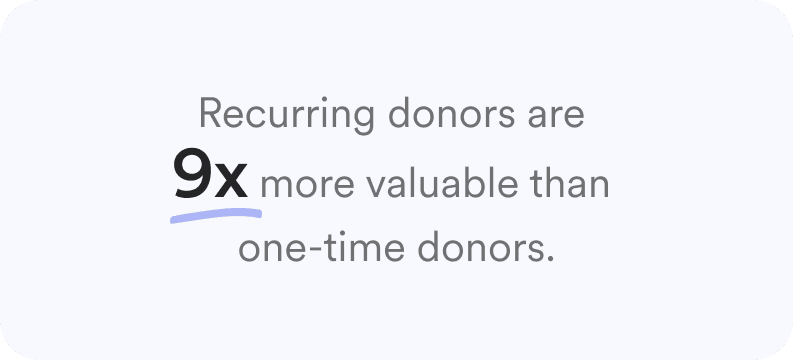
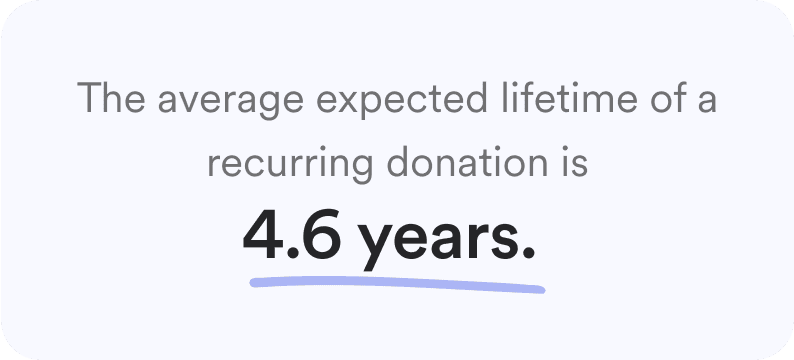
This playbook will include examples from organizations that have launched and grown large-scale, high-performing recurring giving programs so you, too, can grow this predictable stream of revenue.
Follow along in the downloadable workbook to jot down ideas, ask yourself questions, and consider how you can bring these strategies to life in your organization.
Step 1: Set recurring giving goals
When growing your recurring program, it’s important to set achievable goals to measure success and stretch goals to push your organization to exceed expectations. Review your current set of KPIs to ensure you’re monitoring the most relevant metrics. This helps you identify program performance gaps or opportunities for growth.
Start by looking at metrics like:
- The current number of monthly donors
- Average recurring gift size
- Monthly recurring revenue
- Lifetime value (the average amount a donor will give over their lifetime)
Now, set goals for each of these metrics. Is your goal to increase monthly donors or increase the average gift size of your existing pool? Or both? Decide what percent of your total revenue you want to come from recurring donations and tinker with these metrics until you are able to get there.
Activate with Classy
Classy’s recurring donation platform has a pre-built dashboard that allows you to track important recurring giving metrics, including average transaction size, active recurring amount, active and failed recurring plans, and more. Use this first-party data to benchmark your own recurring performance, reconsider growth targets, and cultivate donor loyalty.
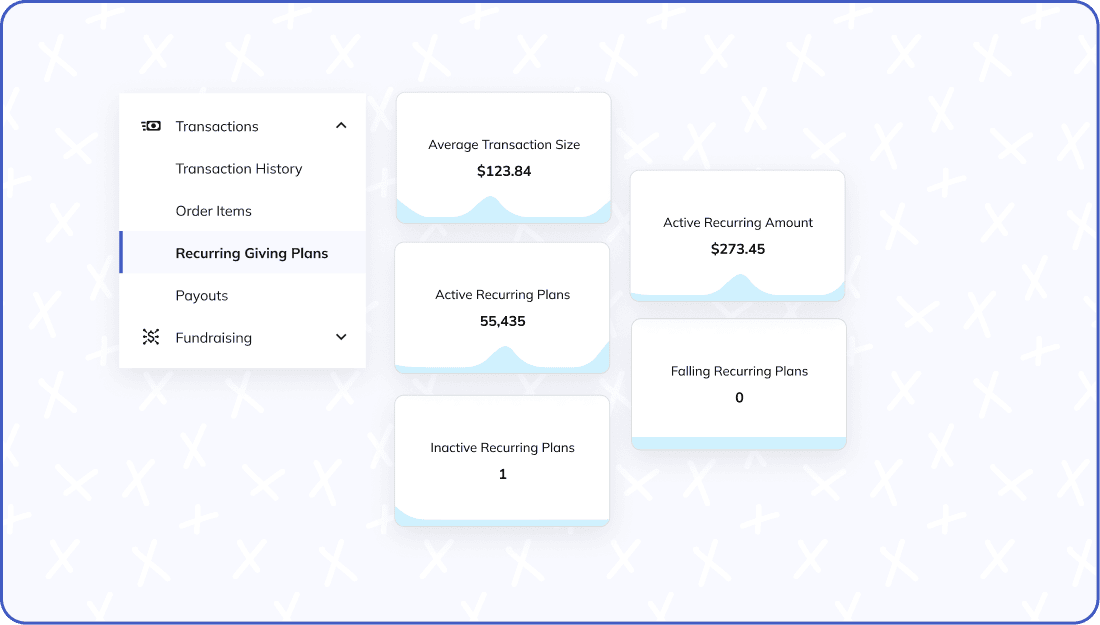
Step 2: Identify and connect with potential recurring donors
The first step in growing your recurring giving program is looking at different audience segments and identifying potential recurring donors. Then, narrow down that list and qualify those who are most likely to upgrade.
Key audience segments to target:

Repeat donors
Anyone who has donated multiple times to your organization but has yet to create a recurring giving plan.

Fundraisers
Anyone who has proven commitment to your cause by raising money on your behalf.

New donors
Anyone who has just given to your organization for the first time.

Event attendee
According to SOMP, 91% of event attendees are more likely to take further action with a nonprofit after a positive event experience.
The State of Modern Philanthropy found that nearly 1/3 of first-time donors who become recurring donors do so in the first 90 days. Use this perfect window of opportunity to communicate with, activate, and re-engage these donors to nurture them into lifelong supporters.
Activate with Classy
Segmentation is the best way to identify and qualify potential recurring donors. Classy has pre-built reports, such as Returning One-time Donors, or you can create your own report of fundraisers, event attendees, or new donors from Giving Tuesday to help you zoom in on which segments you should target. The first-party data available within Classy gives you a better understanding of user behavior and engagement metrics of anyone in your database, which will help further personalize interactions with them across all digital channels.
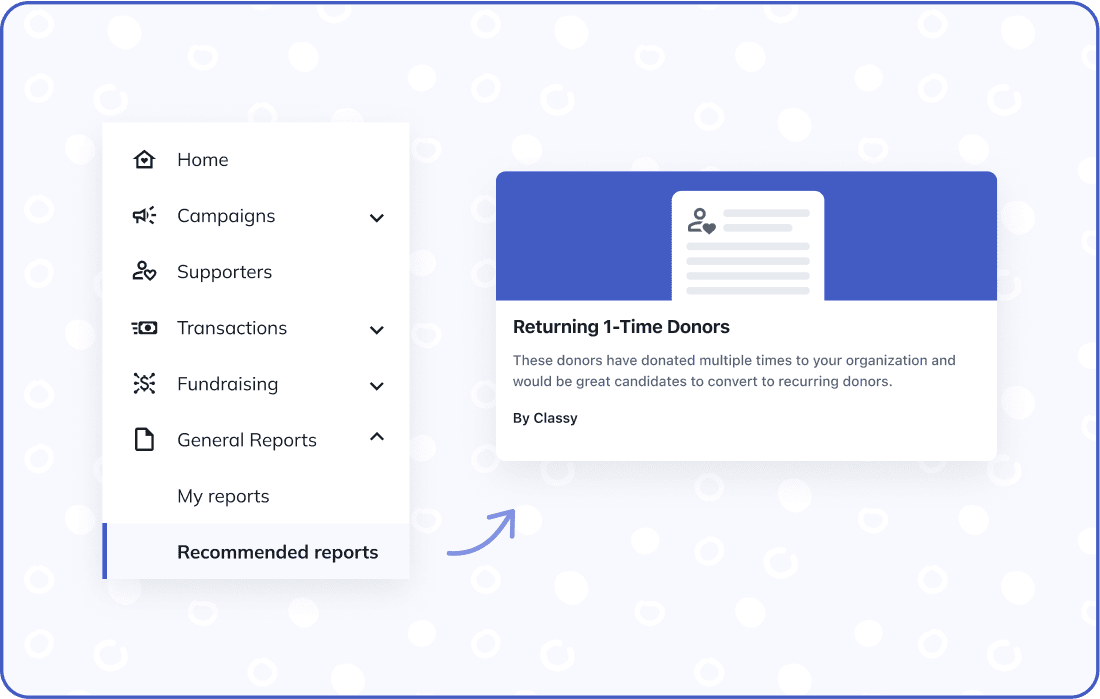
Step 3: Communicate with potential recurring donors
Now that you have identified those who have the highest potential for upgrading to a recurring gift, it’s time to start cultivating the relationships.
This could include at least two of the following touchpoints:
- Educate your audience on the impact of your recurring program,
- Provide updates on current fundraisers,
- Emphasize the impact of a previous gift,
- Share stories or blogs,
- Mention volunteer opportunities,
- Ask for feedback in a survey.
Think of these touchpoints as a “primer” for your monetary ask. This donor education should span across multiple channels, including your website, email, social media, and direct mail.
Focus on establishing a meaningful connection with the potential recurring donors. The main call to action (CTA) should not be a direct ask but always include a way to make a donation to not hinder the ability to give.
How Denver Rescue Mission communicates with potential recurring donors
Through a variety of digital channels, including emails, texts, and evergreen digital ads, Denver Rescue Mission communicates with potential recurring donors and shares its impact on the community. This strategy is about establishing meaningful connections, communicating the impact of a gift on the community, and expressing the need for support.
The team does not restrict the ability to give. Regardless of the type of communication, there is always a CTA to a dedicated Classy campaign with the option to give monthly.
We segment our communication based on the frequency of giving, such as frequent one-time donors, and target them with some specific messaging. Recurring donors are a cornerstone of our donor support structure, so it’s worth investing in cultivation and stewardship content.
Robert Bogan
Digital Marketing Manager at Denver Rescue Mission
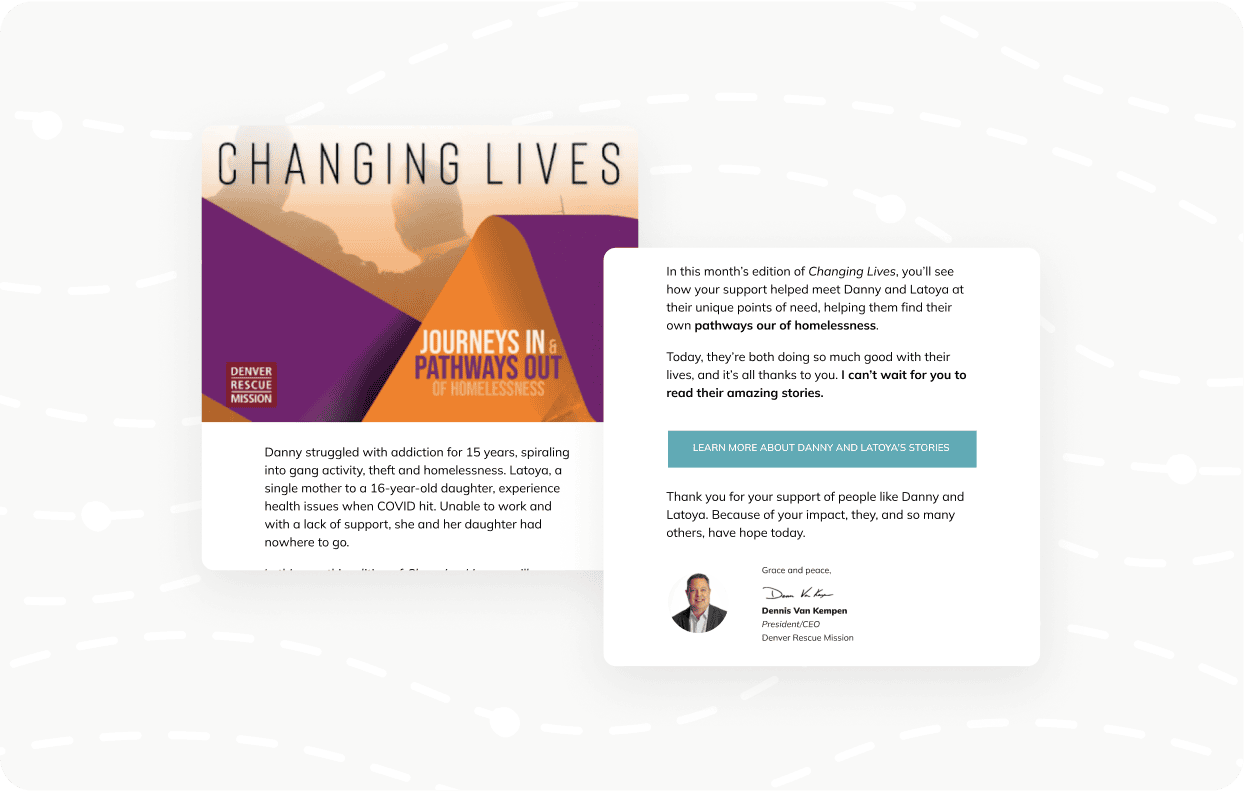
Step 4: Formulate an ask for potential recurring donors
You’ve laid the groundwork and given your audience all the information they need to decide to become monthly donors, so now it’s time to make the ask.
Keep including the “why” and “how” in your communications: Why your organization needs recurring support and how their contributions will change the lives of those you serve. Include reminders about how easy it is to make a recurring donation and share any unique incentives an individual will receive as a monthly donor to your organization.
How the Tunnel to Towers Foundation formulates an ask for potential recurring donors
The Tunnel to Towers Foundation’s recurring giving program informs its entire marketing strategy. In every channel Tunnel to Towers employs to drive new recurring donor acquisition—broadcast, paid digital, social, PR, and direct mail—the CTA is always the same: Become a recurring donor for just $11 a month.
The ask is sweetened by offering recurring donors exclusive content, access to events, discounts, or free Tunnel to Towers merchandise. This is also an opportunity to deepen relationships with recurring donors and make them feel a part of the community.
It may sound obvious, but many donors would make recurring donations if you just ask. $11 a month is a relatively accessible amount to many Americans but makes a significant impact by sheer volume.
Larry Olson
Senior Vice President of Marketing and Communications at Tunnel to Towers
The message is simple, and the ask amount is accessible. For a relatively small amount of money, a donor can help pay off the mortgages of American heroes. This strategy has worked so well that almost ¾ of the Tunnel to Towers Foundation’s online revenue in the past year is from recurring donations.
Tunnel to Towers Foundation TV ad example with $11 recurring donor program ask
Activate with Classy
When communicating with and formulating an ask for potential recurring donors, provide a clear and easy path to make a monthly commitment when the time is right.
With Classy Studio, you can set up a standalone recurring giving campaign to present a cohesive message and use it as the CTA in all of your communication streams. Pre-select monthly as the giving frequency or make it the only option. By implementing Classy source codes, you can track exactly which channel a supporter came from, whether that’s an email A/B test or promotion on social media.
Implement an embedded donation form on your website homepage with both one-time and recurring donation frequencies to allow donors to complete their gifts in a simple, streamlined form. An always-available option is to implement a recurring nudge, which puts a monthly ask in front of anyone who comes through your website.
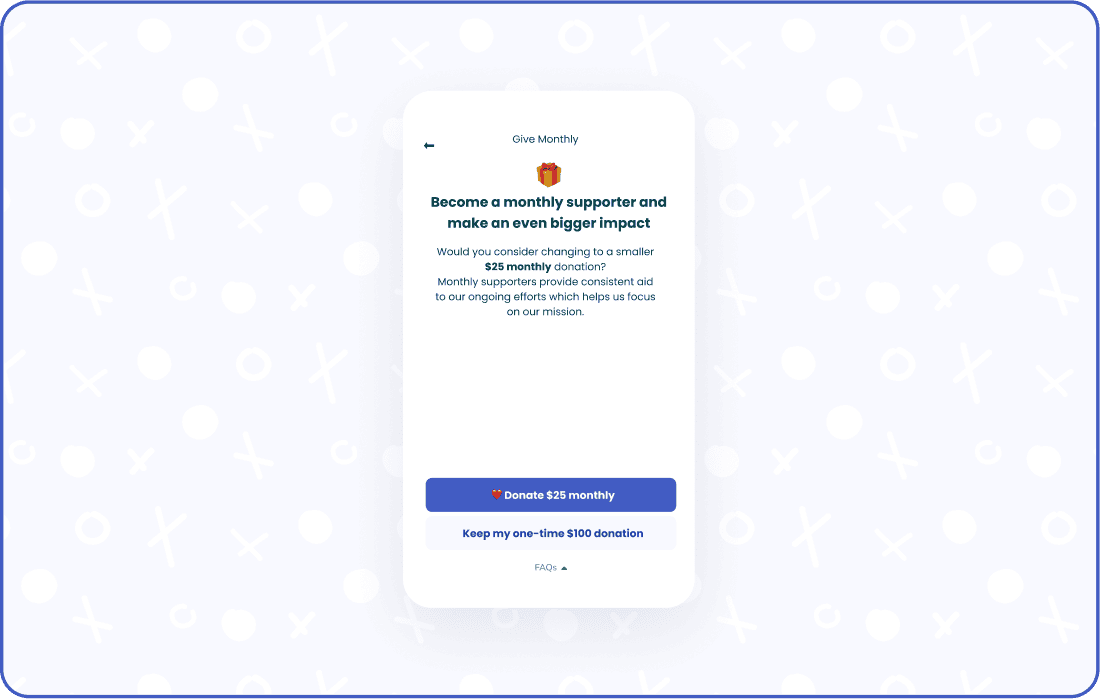
Step 5: Nurture recurring donors
Once someone signs up to become a recurring donor, don’t just set them and forget them. These are your most passionate donors who believe in your cause enough to donate money on a regular basis. Use this as an opportunity to welcome them into the fold and ensure they have a clear path forward to become an ingrained member of your community.
Put in place a cohesive nurture or stewardship strategy to help reduce recurring donor churn and maximize lifetime donor value. A well-rounded stewardship program ideally includes a mix of the following:
The whats and hows for nurturing recurring donors
What:
Send emails from a real person’s email address. Shockingly, only 1 in 5 organizations do this.
How:
Add a name and face to your recurring program communications to make them feel more personal.
What:
Acknowledge and thank your new recurring donors.
How:
An initial welcome and thank you should be sent within 24 hours of a donation.
What:
Recognize and elevate recurring donors.
How:
Spotlight donors in a newsletter or other channels. Make sure to get permission from your donors before recognizing them publicly.
What:
Have a year-round communication plan that includes ongoing engagement. Shockingly, few organizations acknowledge recurring gifts after the first 90 days.
How:
One email can be stretched into a series. Set up an automated stewardship sequence to save on team resources.
Use this as an opportunity to be transparent about upcoming communications, explain the work you’re doing in impact reports, extend exclusive invitations to participate in events or activities throughout the year, and conduct donor surveys.
What:
Communicate with donors who have lost or canceled cards. 24% percent of lost cards and 47% of canceled cards received no communication.
How:
Have a strategy in place to mitigate this type of churn or to retry payment information.
How Tim Tebow Foundation nurtures recurring donors
After someone becomes a recurring donor to the Tim Tebow Foundation (TTF), the team focuses on five immediate touchpoints:
1. Thank you page
2. Donation receipt
3. Automated email introducing the TTF brand and expressing gratitude
4. T-shirt and welcome card
5. Impact story email
To mitigate recurring donor churn, it utilizes Classy’s re-process technology around the first and 15th of every month. The first time a recurring gift fails to process, a personalized email is sent from a TTF team member’s inbox, inviting them back into the recurring community and sharing how their impact is critical for the mission.
In the last 13 months, TTF has grown its recurring donor program from around 6,700 to almost 20,000 individuals. The best part? The nonprofit has achieved a recurring retention rate of 90% year-over-year.
I often say, when a recurring donor sees the monthly TTF charge, I want their immediate feeling to be joy, gratitude, and confidence. We believe the number one thing we can do to impact donor churn is to obsess over the donor’s impact by asking ourselves, “Do they trust that TTF is using their gift to impact the most people? Do they think of TTF and feel a sense of joy that they are part of a global mission?”
Kyle Roosen
Senior Marketing & Communications Director at Tim Tebow Foundation
Activate with Classy
Classy’s recommended reports for mitigating recurring donor churn include “Upcoming Expiring Recurring Plans,” “Failing Recurring Giving Plans,” and “Recurring Plans over 1 Year.” This robust first-party data makes it easy to identify donors who have lapsed and come back, segment and communicate with donors, and prevent churn due to lost or canceled cards.
The recurring retry, which uses automatic logic to signal why a payment failed and whether/when to retry, has saved Classy’s nonprofit customers over $1M per month in missed donation volume.
With Classy’s Supporter Center, your donors can manage their recurring donations through their supporter profiles independently. They can adjust their donation amount, pause or extend the end date of their plan, reactivate or resume a paused or canceled recurring plan, and update payment information.
Recurring donor program key takeaways
Now, you’re ready to grow your recurring donor program. Every program is different, so do what is right for your organization and your supporters. Here are a few key takeaways to keep in mind.
- Don’t wait to prioritize a recurring donor program. You don’t need to have all the bells and whistles of a full-blown program. It could be as simple as adding a monthly option to your donation form.
- Data is your friend. Use it to identify and qualify potential recurring donors and communicate with them effectively.
- Forge relationships with potential recurring donors. Develop a relationship with donors and establish their trust before asking for a monetary donation.
- Get creative in your communication strategy. Bring personalized information to your biggest supporters and convey the impact your organization makes.
- Continue to nurture these relationships. The stewardship process starts when they sign up to become recurring supporters. Continue to communicate with them, recognizing them for their loyalty and showing them the substantial impact of their gifts.
Need help diving into your own recurring program?
Reach out to your Account Manager or start a conversation with our team.
Boost your nonprofit’s recurring giving strategy
Ready to grow?
Success!
Our team will be in touch shortly to share how Classy can power your online fundraising.